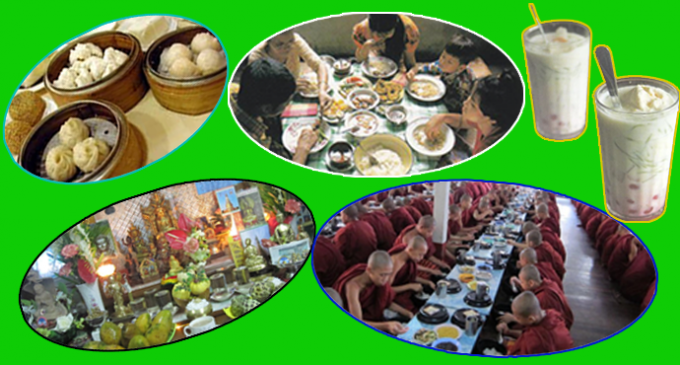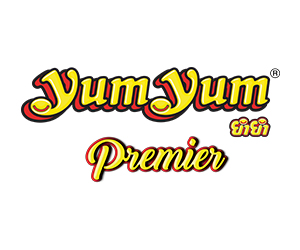Myanmar Food: Traditional and change II

The parcel crepes are delicious.
Another drink from Thailand is mok-let-saung, green coloured rice jelly strips served with cooled coconut milk mixed with jaggery or sugar. The Myanmar name comes from the Thai laut chaung, mok being the Myanmar generic word for any cake or snack.
Dining Room and Tables
There is usually a separate dining room for meals, located between the living-drawing room where guests are received and the pantry and kitchen, at the back of the house. If a sep-arate room is not available, at least a segregated or partitioned part of a larger room will be made for the table where food is consumed.
Traditionally Myanmar people have used small round tables only about one foot in height, where the family would sit around on floor mats, each with a platter of cooked, boiled rice with the meat, fish, vegetable dishes and the soup bowl placed in the centre with a few spoons for all, making it easy for those sitting around to dip into what they want to eat with their rice. It is similar to the Thai traditional way of eating.
Nowadays, since colonial times from around mid-19th century, higher western style dining tables and chairs have been used especially in the towns and cities, though in the villages where about 75 percent of the people live, the peasants still prefer the low round tables for the family to sit around on mats to eat. Max and Bertha Ferrars in a book profusely illustrated with good photographs taken by them and published in 1901 wrote that the old style of eating was having the dishes placed in a huge woven bamboo round tray on the floor and the “new” style with the small round slightly raised tables.
The food is delicately eaten only with the right hand, using all the five fingers only up to the second (or middle) joint with rice picked up, mixed with a small portion of either meat or vegetable dish. Spoons were used in earlier days only for soups, as it was not drunk from a bowl like the Japanese. The Myanmar style of eating with the fingers is not as genteel as the Thais where only the three middle fingers are used.
From colonial times European style forks and spoons and table knives have become more common in the majority of houses in the urban areas, with separate smaller bowls of soup for each person which can be refilled by maids and helpers throughout the meal. Usually there is also a central dish with fresh or boiled vegetables and a small bowl of dips made from fish paste; this is eaten as a relish.
As we have not adopted the European manner of serving food course by course, but eating all the dishes together with the rice, the traditional small round tables are ideal for a family meal. But in modern times no one likes to sit on the floor, so guests and a long table has to be utilized, usually two sets of curries, soups and dips are put on the table, as they should all be, ideally, within easy reach of everyone.
Even the Buddhist monasteries which are very conservative and have been using the traditional small round tables for ages, are changing in the last decade especially for lay guests at special feasts, by replacing them with modern tables and chairs, though many of the monks will only eat at the traditional low tables, sitting on small carpets or mats on the floor.
Eating Out
Consuming our daily food at home is convenient and bonding for the family members. At the same time Myanmar people occasionally like to eat out for variety and change depending on your time and the expendability of your purse, same as with other people all over the world. Some dishes are too time-consuming and complicated to cook at home and easier to pay and enjoy hassle free at a cafe or restaurant, and of course some non-traditional dishes are available only outside the house and have not come into our kitchen for daily fare. Also, we like to entertain guests sometimes with special food not available in our houses.
In towns and cities there are many tea and coffee shops which open early where you can enjoy a breakfast not only of mohhinga, but Chinese dumplings (called pauk-si) deep fried twisted dough sticks called ee-kya-kwei (from Chinese youzha qyi) and also some ethnic dishes like Shan noodles, or European style patties, sandwiches, dim sums and many other tasty morning snacks.
For breakfast we can have mohinga at home but many go to the famous mohinga sellers like Tin Tin Aye or Myaung Mya Daw Cho and Sanpya Daw Kyi. Some take a fancy to special broths which are supposed to have originated in regional towns like Hinthada or Kyaiklat, as some of the fish gravy-soup are different from the usual common one, for example the Rakhine mohinga with its clear fish soup, with nga pi (fish paste) but no banana pith, spiced up with ample applications of fiery pepper.
In the last fifteen years or so, Dim Sum shops have become very popular for breakfast and lunches, a new innovation formerly not found in Myanmar, coming from China, espec-ially Hong Kong, and some Southeast Asian countries like Singapore and Thailand where dim sum have been popular for many years.
Earlier, Indian food have been popular for eat outs to enjoy many varieties of parata, chapartee, roti, dosa which the Myanmar call to-shay (short and long) with dhal or hot spicy curries, both vegetable and meat.
When Myanmar first became icorpora-ted into the British Empire parts of Myanmar along the coast Rakhine (Arakan) and Taninthayi (Tenasserim) from 1826, and later from 1886 the whole country, she was governed as a pro-vince of India right up to 1937. During those (90) years many Indians came over to settle in Lower Myanmar. At one time Rangoon, the capital before World War II, was more of an Indian city; Indian cuisine therefore became popular with the Myanmar not only in restau-rants but also entered home cooking or take-aways eaten in the house.
Up to early 1960s there were many Indian eateries centred around Mogul (now renamed Shwebontha) Street with an open air night market area opposite the Scott (Bogyoke) market where Indian food vendors would noisily and rather aggressively entice passersby to eat at their small stalls, vying with each other to get as many customers as possible.
But by 1964 when the massive nation-alizations of private businesses and factories took place under the socialist, military, Revolu-tionary Government, thousands of Indians left, special ships being sent to pick them up. Since then Indian cafes and restaurants have gone down drastically in number; but from the 1990s many more Chinese have immigrated across the border from Yunnan and big cities like Yangon and Mandalay are now full of Chinese food outlets, from small pavement stalls of Chinatown to expensive upbeat restaurants like Shwe Bè, (Golden Duck) which are popular with the growing number of the newly rich upper class.
Myanmar food outlets also abound all over the country. In Yangon a popular chain where authentic, tasty Myanmar food at reasonable prices can be obtained is the Danubyu Daw Saw Yee, Myanmar restaurants (named after the lady who founded them, originally from Danubyu town on the Ayeyarwady delta). Another popular restaurant for typical Myanmar food is Shwe Bè though it is not the official name, but the name of a popular actor (known for his tough fighting skills) who used to frequent the original restaurant in Myenigone at the northern foot of the famous Shwe Dagon Pagoda which towers above Yangon.
A new restaurant chain now becoming very popular in recent years is “feel”, found in Yangon (several outlets), Pyin-Oo-Lwin (May-myo, on the Shan Plateau) and along the Yan-gon-Naypyidaw (new capital about 275 miles north) highway. At “Feel” not only typical Myan-mar dishes, but Thai, Chinese, Malay and Indian food are also available.
Another modernization which provided new, exciting opportunities for eating out came with the construction and opening of many new hotels housing high class restaurants in Yangon and Mandalay. Also in other tourist towns like historic, ancient city of Bagan (11th to 13th cen-tury), Inle (a place of lake-dwellers on the cool Shan Plateau) and lovely seaside resorts like Ngapali, Ngwe Saung and other places. This began around 1990 and is still an on-going process with many hotel chains especially from Thailand, Singapore, and China in north-eastern border region, opening various types of hotels from grand ones like Kandawgyi Palace built by the Baiyoke group and Chatrium (Thai), Sedona and Traders (Singaporean), to smaller Yunnan style hotel in border towns.
This rapid development in the last decade of the 20th century came about with the military government opening up of the country to foreign investment after abondoning socialist policies in 1988.
Now we can go to Japanese style restaurants with low tables where it is possible to put your feet down into a recess in the floor. Good tasty sushi, tampura and various other Japanese food are now being enjoyed by the Myanmar, especially the growing number of a rich upper middle class and the elite of the country. Also Korean, Thai and Western cuisine is available in some hotels.
Western style buffets, International, Asian, seafood, etc. are also popular, together with barbecues and grills. Many beer pubs have also been opened and become places where snacks and barbecues are also enjoyed by young men and women in the evening.
Smaller cafes like Black Canyon from Thailand have outlets in Yangon, and the Myanmar have found Thai food very palatable to their taste.
There are also a few Italian restaurants with pasta and pizza, and French ones where even truffles and frog-legs can be ordered. Before long McDonalds and KFCs outlets, will be starting in Myanmar.
Food Culture and Customs
Religious and Social
Nearly 90 percent of the people of Myanmar are Theravada Buddhists and they practice a food culture related to their religion.
At morning prayers, soon after getting up, a tiny portion of cooked rice from the family pot, together with a thin slice of fruit, or a small cake or two is offered in front of the Buddha image, at the altar in the shrine room found in all Buddhist homes. There are usually also a few tiny cups of water together with flowers, candles and increase.
Once or twice a year, at birthdays death anniversaries or some special occasion in family life like a naming ceremony of a new-born infant, a wedding or a funeral, several monks are invited for a dawn (5:30- 6:30 am), or morning meal (between 10:11 am) for traditonal Myanmar food or one-meal dishes like mohinga, ohn-no khauk swe (coconut soup noodles) and some offerings of uncooked rice, biscuits in tins or packets and other dry foodstuffs, including cooking oil for the monastery are given.
There are two parts to these ceremonies, the first part where the monks officiate, where dry foodstuffs and other gifts are offered, prayers recited, a short sermon delivered by the chief abbot and the merit thus accrued shared both with the living and the dead. The monks then partake a meal and leave.
After the monks have departed, the second part of the ceremony which is purely social will begin. Relatives and friends will all join together in a feast, a meal of traditional Myan-mar food or as mentioned earlier of one dish meals. The monks do not officiate at weddings or other social gatherings as they have renounced the world to live religious lives in the seclusion of their monasteries. But newly weds often offer swoon-chway meals to monks, at a monastery or at their home soon after.
Food offerings are often given at monasteries at swoon-chway in the morning, because the monks keep sabbath from noon to dawn the next day when no solid food is eaten, but only nonalcoholic drinks are allowed.
Food offerings can be of two kinds: soon which is cooked rice together with various curries, or soon-hsan-sein, when uncooked rice and other “dry” foodstuffs are donated. It can be at the monasteries, or during the daily rounds the monks and novices make in the morning to collect cooked food in their black bowls. Buddhist devotees will wait at their gates and put into the monks’ bowl spoonfuls of rice and curries which the monks are supposed to eat all mixed together with various curries from each household as their precepts allow them to consume food only for nourishment, to sustain life, and not for enjoyment. But this Vinaya rule is seldom strictly followed except by a few very disciplined sects like the Shwe-gyin. In the month of Tabaung (usually around mid-March to early April) normally on the Full-moon Day, devotees will offer uncooked food, rice and cooking oil, together with other requisites of the monks from new yellow robes to candles, also what is known as “dry rations”: biscuits, sweet, canned food, and so on. This sort of offering of uncooked food and other “preserved” food is also offered at novition ceremonies and when all Myanmar males have to enter the monk hood at least once in their life, usually at age 20.
Offerings to Nats
Although about 90 percent of the Myanmar have been Buddhists for over a thousand years, underneath the tolerance and moderation of the Middle Way of their religion has survived earlier animistic beliefs and the strong influence of the nat spirits who have to be propitiated with food offerings.
Each village hut and also many houses in the towns and cities have a lower altar below the one for the Buddha images; this is for food, flowers, fruits and candle offerings to the nat spirits. Sometimes these altars, or spirit shrines are in a separate area, but usually not far from the main Buddha shrine in the house, though unlike the Thais, the Myanmar do not build beautiful Phi spirit shrines in their front garden or compound.
The food offerings are not elaborate. There is usually a large green coconut with a sprig sticking out for Maha Giri, the “Lord of the Great Mountain”, who heads the main 37 Nats venerated by many Myanmar. Some bananas and other fruits are also offered.
Outside the house under big banyans or other large trees can be found little shrine houses for the tree nat, the yoke-ka-soe. Different regions or ethnic groups of Myanmar also have their own nats or guardian spirits as among the Mons, the Shans, Kachins and Chins, where various types of cooked or uncooked food are offered to placate them and get their protection and assistance.
Social Customs
There are several social customs related to food such as younger people putting a spoonful of various dishes on the rice plate of elderly persons who are eating together on the same table.
Every year at the begin-ning and end of the Buddhist Lent (during the monsoon rains from about June to September) younger relatives or former students will bring some uncooked food, especially fruits when they come to pay respects to their elders, parents and teach-ers. Parents are also brought such foodstuffs by their children, nephew and nieces, as food forms an important ritualistic role and bonds the extended family.
The Myanmar have monthly festivals throughout the year, usually on full-moon days, as traditionally they have used a lunar calendar. Some foods are made in connection with certain festivals, for example during the month of Tabodwe (usually between February and March) a sticky rice dish is cooked with peanuts, shredded coconut, seamum and ginger in large frying pans over an open fire in the garden. It is called htama-nei, which is shared with friends and relatives, a seasonal delicacy much appreciated by Myanmar people.
In Lower Myanmar, especially in the Mon State around Mawlamyine (Moulmein) at the Myanmar New Year (usually in mid-April) water festival and throughout the hot summer months when green mangoes are just right for making salad, a delicacy called Thingyan hta-min (Thingyan New Year rice) is eaten; it is cooked rice loosely soaked in cool fragrant water, eaten just with fried pounded, dried fish, or prawns and a salad made of green mangoes mixed with pounded dried prawns, fish sauce, onions, etc.
Although these seasonal delicacies have not changed, with modernization and the importing of foodstuffs from abroad, there is now much more variety in the type of food offerings in social and religious ceremonies.
Instead of the traditional mohinga, monks are often offered Indian barayini rice called dan-bauk, or Chinese noodle dishes and Thai soups and curries.
Also at paying respect to elders and teachers ceremonies, canned food, imported apples and pears, even kiwi fruit from New Zealand, or “sun-kissed” oranges from Califor-nia are now given as offerings.
At wedding receptions in newly opened grand, modern hotels, all kinds of European food, cakes, ice-creams, drinks, dinners with exotic dishes are special treats for guests. As the rich get richer, and the poor, poorer there is a new class of elites who thrive on expensive imported food. But out in the villages where the majority of the people live Myanmar traditional food has not changed much.
Dr Thaw Kaung with the assistance of Dr May Moe Nwe
./wp-content/uploads/2018/10/Emirate-Online-TDY.png)
























There are no comments at the moment, do you want to add one?
Write a comment